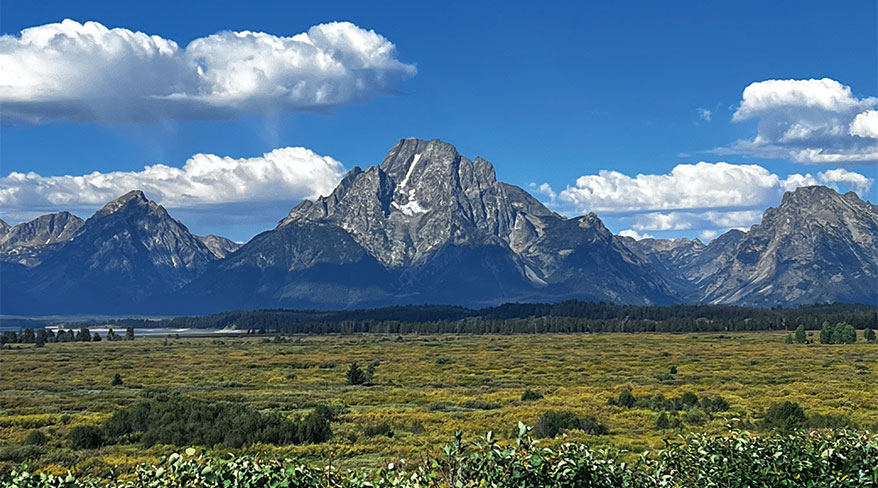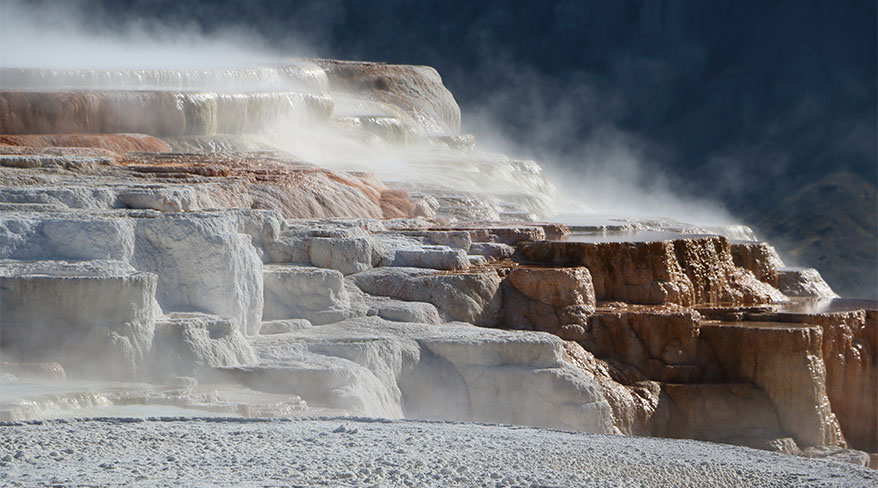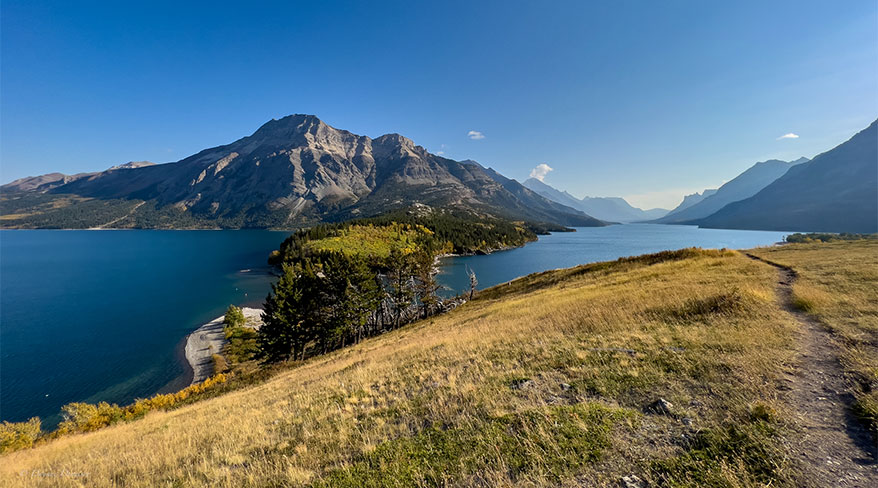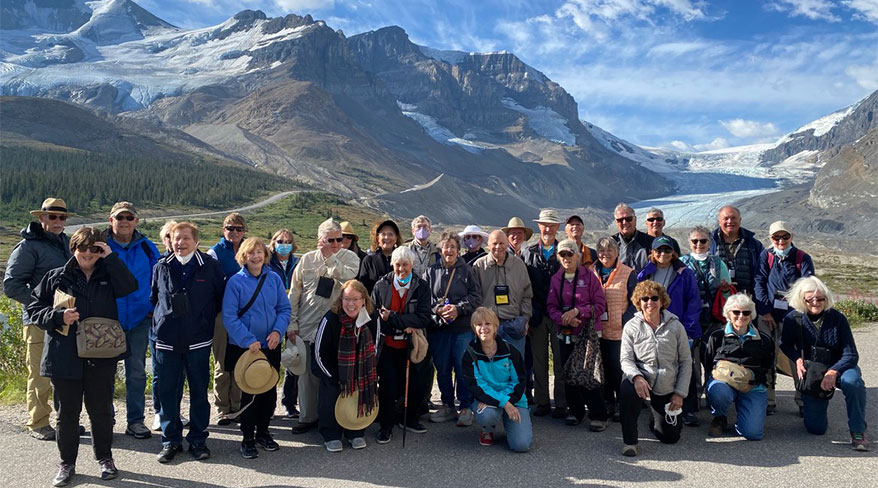Wyoming/Montana/Alberta
The Best of the Grand Tetons to Banff: Iconic National Parks
Program No. 20524RJ
Explore six national parks — Grand Teton, Yellowstone, Glacier, Waterton, Banff and Jasper — and discover unique waypoints like Old Faithful, Many Glacier, Lake Louise and much more!
Itinerary
While we make every effort to ensure the accuracy of our published materials, programs are typically advertised more than a year prior to their start date.
Read More.
While we make every effort to ensure the accuracy of our published materials, programs are typically advertised more than a year prior to their start date. As a result, some program activities, schedules, accommodations, personnel, and other logistics occasionally change due to local conditions or circumstances. Should a major change occur, we will make every effort to alert you. For less significant changes, we will update you during orientation. Thank you for your understanding.
Duration
12 days
11 nights
What's Included
30 meals (
11B, 9L, 10D
)
6 expert-led lectures
17 expert-led field trips
An experienced Group Leader
11 nights of accommodations
Taxes and customary gratuity
Road Scholar Assurance Plan
Day
1
Check-In, Orientation, Welcome Dinner
Location:
Jackson Hole
Meals:
D
Stay:
The Rockwell Inn
Activity Note
Hotel check-in from 3:00 PM.
Afternoon:
At the time of check-in, collect your Road Scholar Welcome Packet from the front desk. In the packet you will find information regarding program details, including the location of orientation. The program orientation will begin at 4:30 PM. The Group Leader will greet everyone and lead introductions. They will review the up-to-date program schedule, discuss roles and responsibilities, logistics, safety guidelines, emergency procedures, and answer questions. There may be some light paperwork at the end of the orientation session. If you don't arrive in time for orientation, please refer to your welcome packet on how to locate the Group Leader and get caught up on any information you may have missed. Lectures and field trips will be led by local experts and a knowledgeable Group Leader. Transportation for program-related activities will be via motorcoach and Red Jammers, unless specified otherwise. Periods in the daily schedule designated as "Free time" and "At leisure" offer opportunities to do what you like and make your experience even more meaningful and memorable according to your personal preferences. The Group Leader will be happy to offer suggestions. Program activities, schedules, personnel, and indicated distances or times may change due to local circumstances/conditions. In the event of changes, we will alert you as quickly as possible. Thank you for your understanding.
Dinner:
At the hotel.
Evening:
At leisure. Continue getting to know your fellow participants, settle in, and get a good night’s sleep for the day ahead.
Day
2
Natural History Presentation, Grand Teton National Park
Location:
Jackson Hole
Meals:
B,L
Stay:
The Rockwell Inn
Activity Note
Getting on/off a motorcoach; driving about 90 miles, approximately 2.5 hours total drive time with multiple stops.
Breakfast:
At the hotel.
Morning:
We'll kick off our discovery of the Rocky Mountains with a natural history lesson presented by a local expert to aid in our understanding of the creation of the majestic Rockies. Next, we'll take what we learned and join the local expert on an educational adventure into Grand Teton National Park. While on field trip we'll learn about Grand Teton's unique geological features, glacial movement, and impressive array of flora and fauna.
Lunch:
At a restaurant inside Teton National Park.
Afternoon:
We'll stop at the Snake River overlook where Ansel Adams captured early, iconic photographs of the area's beauty. We'll also stop at the iconic Mormon Row, where we'll learn about the hearty homesteaders that first arrived here in the 1890s. As we make our way back to Jackson, be on the lookout for bison, moose, elk, and pronghorn grazing in the sage steppe. Enjoy an afternoon of leisure to explore Jackson's vibrant western downtown and the famous antler arches of the town square.
Dinner:
This meal has been excluded from the program cost, and is on your own to enjoy what you like in Jackson. The Group Leader will be happy to offer suggestions.
Evening:
At leisure. Be sure to prepare for check-out and transfer in the morning.
Day
3
Grand Teton National Park, Yellowstone National Park
Location:
Canyon Village
Meals:
B,L,D
Stay:
Canyon Village Lodge
Activity Note
Getting on/off a motorcoach; driving about 170 miles, approximately 4.5 hours total drive time. Multiple stops are made along the route. Walking up to one mile.
Breakfast:
At the hotel.
Morning:
We'll board the motorcoach and make our way to Yellowstone National Park. Along the way we'll stop and self explore the historic Jackson Lake Lodge. Built on a grand scale, this 1950s lodge has sixty-foot-high windows that perfectly frame the Teton range. A short distance from Jackson Lake Lodge, we'll begin our exploration of Yellowstone National Park, a volcanic hot spot of epic proportions. Hydrothermal features are fragile rarities of nature and Yellowstone National Park preserves the largest collection of hydrothermal features on the planet. An exploration of the West Thumb Caldera will give us the chance to visit geysers, hotsprings, mudpots, and fumaroles.
Lunch:
At a restaurant inside Yellowstone National Park.
Afternoon:
As we travel deeper into the heart of Yellowstone, keep your eyes sharpened as we pass through Hayden Valley. This lush area is a hot spot for bison, bears, and other wildlife. At the North end of Hayden Valley lies the Grand Canyon of Yellowstone. This magnificent canyon formed after a huge volcanic eruption and subsequent lava flow. The soft rock was easily eroded by the Yellowstone River creating one of the most magical views in Yellowstone - the Lower Falls from Artist Point. Framed by the canyon walls, the Yellowstone River thunders more than 308 feet over Lower Falls, creating a dynamic focal point. The canyon is home to birds of prey such as bald eagles and osprey. Later this afternoon, we'll check into Canyon Village, nestled inside Yellowstone National Park.
Dinner:
At Canyon Eatery.
Evening:
At leisure. Continue getting to know your fellow participants or explore more of the beauty of Yellowstone as you take a stroll around Canyon Village. If open, consider exploring the Canyon Village Educational Center to learn more about Yellowstone's dramatic landscapes.
Day
4
Yellowstone National Park, Old Faithful Geyser
Location:
Canyon Village
Meals:
B,L,D
Stay:
Canyon Village Lodge
Activity Note
Getting on/off a motorcoach; driving about 100 miles, approximately 4.5 hours total drive time. Opportunities to step out and explore stops on boardwalks and paths, walking up to one mile.
Breakfast:
At Canyon Eatery.
Morning:
Yellowstone National Park boasts one of the most extreme, rare, and fragile hydrothermal ecosystems in the world. Today, we’ll be joined by a local expert on a detailed field trip through Yellowstone National Park and learn about it's history, creation, and unique formations. Old Faithful Geyser is neither the tallest nor the most frequently erupting geyser in Yellowstone, but that doesn’t stop it from being the most iconic feature in the park. We’ll make a stop at Old Faithful and discover why it's the most popular geyser and the history behind its predictableness, as well as learn about the surrounding geyser formations.
Lunch:
At a restaurant inside Yellowstone National Park.
Afternoon:
We’ll continue to learn more about Yellowstone’s rare and fragile ecosystems as we progress through the heart of Yellowstone with our local expert.
Dinner:
At Canyon Eatery.
Evening:
At leisure. Be sure to prepare for check-out and transfer in the morning.
Day
5
Mammoth Hot Springs, Travel to Helena
Location:
Helena
Meals:
B,L,D
Stay:
Delta Hotels by Marriott Helena Colonial
Activity Note
Getting on/off a motorcoach; driving about 220 miles, approximately 4 hours total drive time. Opportunities to step out and explore stops on boardwalks and paths, walking up to one mile.
Breakfast:
At Canyon Eatery in Yellowstone National Park.
Morning:
This morning, we'll continue our exploration of Yellowstone with our Group Leader as we depart by motorcoach to Mammoth Hot Springs. Mammoth Hot Springs is a large complex of hot springs flowing down a hill of travertine. Deposits of calcium carbonate create the unique appearance of a snow terraced landscape. Boardwalks will get us up close and personal with these amazing formations. Mammoth Hot Springs also serves as the park headquarters and radiates a unique history of its own. It features some of the oldest buildings in the park, including structures from the days when the U.S. Army managed Yellowstone.
Lunch:
Boxed lunch in Yellowstone National Park.
Afternoon:
This afternoon, we'll make our way to Montana's capital city, Helena, and check into our hotel. Helena will be a one-night stop along the way to our next destination, Glacier National Park.
Dinner:
At the hotel.
Evening:
At leisure. Be sure to prepare for check-out and transfer in the morning.
Day
6
Glacier Park Lodge, Cultural Presentation, Many Glacier
Location:
Many Glacier
Meals:
B,L,D
Stay:
Many Glacier Hotel
Activity Note
Getting on/off a motorcoach; driving about 245 miles, approximately 4.5 hours total drive time. There will be restroom stops and time to stretch your legs along the way.
Breakfast:
At the hotel.
Morning:
After checking out of Helena Colonial, we'll travel northeast by motorcoach to Glacier National Park with plenty of restroom stops and time to stretch our legs along the way.
Lunch:
Boxed lunch en route.
Afternoon:
This afternoon, we’ll take a stroll through the historic Glacier Park Lodge and get a feel for the architectural ingenuity of this beautiful lodge. With its massive Douglas Fir and Cedars supporting the main structure, the logs and timbers are an engineering art form. Following our lodge exploration, we’ll gather for a presentation from a local member of the Blackfeet Nation. We’ll learn about the local culture and its importance to Glacier National Park. After the presentation, we will board the motorcoach and travel to the Many Glacier, where we'll check into the Many Glacier Hotel. Many Glacier Hotel was built in 1914 by the Great Northern Railway as a destination resort for its rail tourists. The hotel sits among soaring peaks and glassy lakes.
Dinner:
At the hotel.
Evening:
At leisure. Many Glacier Hotel is a spectacular site set in one of the most scenic National Parks. It boasts amazing views, a plethora of wildlife, and a relaxing atmosphere to help you wind down after a day of travel.
Day
7
Explore Glacier National Park via the Going-to-the-Sun Road
Location:
Many Glacier
Meals:
B,L,D
Stay:
Many Glacier Hotel
Activity Note
Getting on/off historic Red Jammer. Driving about 80 miles, approximately 4 hours total drive time. There will be opportunities to get out and stretch your legs as well as visit the Logan Pass Visitor Center. There will be opportunities for restroom breaks along the way. Maximum elevation of 6,647 feet.
Breakfast:
At the hotel.
Morning:
This morning, take the opportunity to relax on the deck at Many Glacier Hotel, overlooking the shores of Swiftcurrent Lake. Your Group Leader will be happy to offer suggestions of activities for the morning, as there are several surrounding the historic hotel.
Lunch:
At the hotel.
Afternoon:
Glacier National Park, named for the glaciers that carved it, is the undisputed “Crown of the Continent.” Over one million wild acres crown the Continental Divide, a place where lush green parklands join towering, jagged peaks sporting some of the world’s oldest rocks. Glacier National Park has been described as one of the most intact natural ecosystems in the lower 48 states. This afternoon, we’ll explore the park’s diverse ecosystems by traveling the iconic Going-to-the-Sun Road via historic Red Jammer open-top buses. The Going-to-the-Sun Road is a Historic Landmark, a testament to human ingenuity, and the only road that traverses Glacier National Park. Located along the Going-to-the-Sun-Road is Logan Pass. We’ll make a stop at Logan Pass, located along the Continental Divide, where waters flow toward both the Pacific and Atlantic Oceans. Logan Pass is the highest point on the Going-to-the-Sun Road, with an elevation of 6,647 feet.
Dinner:
At the hotel.
Evening:
At leisure. Be sure to prepare for check-out, transfer, and border crossing into Canada in the morning.
Day
8
Travel to Waterton, Buffalo Jump, Canmore
Location:
Canmore, AB
Meals:
B,L,D
Stay:
Coast Canmore Hotel
Activity Note
Getting on/off a motorcoach; driving about 320 miles, approximately 6 hours total drive time. Periods of standing while in museums. Walking up to 1 mile. Be prepared to have your passport accessible for the US-Canadian border crossing.
Breakfast:
At the hotel.
Morning:
After checking out of Many Glacier Hotel, we'll depart by motorcoach to Waterton Lakes National Park in Canada. Please have your passport accessible for the US/Canadian border crossing. Although active glaciers vacated Waterton's borders years ago, the results of ice gnawing on the landscape left lake pockets strewn through the park, one of these lakes being Upper Waterton Lake, the deepest lake in the Canadian Rockies. In Waterton, we'll visit the historic Prince of Wales Hotel. Designated a Canadian National Historic Site, the 122-foot-tall, four-story hotel took more than a year to build. Constructed by the Great Northern Railway, its massive lobby with floor-to-ceiling windows frame Waterton Lake.
Lunch:
Boxed lunch en route.
Afternoon:
Next, we’ll visit Head-Smashed-In Buffalo Jump, a UNESCO World Heritage Site, which bears witness to an aboriginal hunting practice that was used by native people of the North American plains for almost 6,000 years. We'll stop at this unique site and learn from expert staff about this essential piece of history. This afternoon, we'll arrive at the gateway to Banff National Park in Canmore and check into the hotel. This area is the crown jewel in Canada's National Park system, with its dense coniferous forest and alpine landscapes.
Dinner:
At the hotel.
Evening:
At leisure. Feel free to get settled into your room or roam around the quaint town of Canmore.
Day
9
Banff, Sulphur Mountain Gondola, Wildlife Presentation
Location:
Canmore, AB
Meals:
B,D
Stay:
Coast Canmore Hotel
Activity Note
Getting on/off a motorcoach; driving about 35 miles, approximately 1 hour total drive time. Periods of standing and walking. Getting on/off the gondola. Maximum elevation of 8,041 feet as we take the gondola up Sulphur Mountain.
Breakfast:
At the hotel.
Morning:
This morning, we will explore Banff's historic and scenic spots with our expert Group Leader, starting with the Whyte Museum. Founded in 1968, the museum preserves the culture and history of the Rockies, featuring art and artifacts that showcase Indigenous cultures, early explorers, and tourism. Next, we'll ride a gondola up to Sulphur Mountain. At an elevation of 8,041 feet, the observation deck provides breathtaking views of Banff, Bow Valley, Cascade Mountain, Lake Minnewanka, and the Fairholme Range.
Lunch:
This meal has been excluded from the program cost, and is on your own to enjoy what you like in Banff. The Group Leader will be happy to offer suggestions.
Afternoon:
Take this opportunity for independent exploration of Banff. The area has several museums and local art galleries to explore.
Dinner:
At the hotel.
Evening:
At the hotel, we'll be joined by a local wildlife expert and learn what makes this area so unique.
Day
10
Jasper National Park, Snowcoach Excursion, Lake Louise
Location:
Canmore, AB
Meals:
B,L,D
Stay:
Coast Canmore Hotel
Activity Note
Getting on/off a motorcoach and snowcoach; driving about 260 miles, approximately 5 hours total drive time. Wear warm clothes and bring a coat as it is often snowing on the glacier. While the snowcoach is enclosed, there is an optional opportunity to get out and safely walk on the surface of the glacier.
Breakfast:
To-go breakfast from the hotel.
Morning:
Prepare for an early morning departure as we travel north to Jasper National Park and the Columbia Icefield for an all-day field trip led by a local expert. Along the way, our local expert will educate us on the history, creation, and unique statistics about the Columbia Icefield. Upon arrival, we’ll board an all-terrain Ice Explorer for an excursion onto the Athabasca Glacier where we’ll learn more about the glacier, its impact on the environment and we’ll be able to safely step out onto the ice and get a feel for walking on a 10,000 year-old glacier.
Lunch:
Boxed lunch en route.
Afternoon:
Return trip to Canmore with expert-led scenic stops along the way, including a stop at Lake Louise. As you witness the spectacular beauty of Mount Victoria reflecting in the sparkling waters of Lake Louise, you'll understand why this lake is regarded as one of the most tranquil and beautiful lakes in Canada. Overlooking the magnificent scene, Fairmont Château Lake Louise is, without a doubt, one of the world's most photographed hotels.
Dinner:
At the hotel.
Evening:
Free evening to explore more of the beautiful town of Canmore. Be sure to prepare for check-out and transfer in the morning.
Day
11
Heritage Park Historical Village, Calgary, Farewell Dinner
Location:
Calgary
Meals:
B,L,D
Stay:
Sheraton Cavalier Hotel
Activity Note
Getting on/off a motorcoach and snowcoach; driving about 85 miles, approximately 1.5 hours total drive time. Walking approximately 2/3 mile.
Breakfast:
At the hotel.
Morning:
After breakfast, we'll check out of the hotel in Canmore and depart for Calgary for an expert-led field trip of the city's highlights, including visits to WinSport, Studio Bell, Calgary Stamped, and Olympic Plaza.
Lunch:
At Heritage Park.
Afternoon:
We'll spend the afternoon at Heritage Park learning about the culture and traditions of the Plains First Nations, fur traders, missionaries, and early settlers. We will get a firsthand look at the challenges that faced these groups as well as a glimpse into their daily life. Discover how settlers learned to endure harsh environments, and cultural exchanges that helped them to adapt and survive. Later this afternoon, we'll check into the Sheraton Cavalier, the end destination of our Rocky Mountains exploration. We'll have time to freshen up before our final dinner together.
Dinner:
At the hotel. Share favorite experiences with Road Scholar friends during our farewell dinner.
Evening:
At leisure. Be sure to prepare for check-out and departure in the morning.
Day
12
Program Concludes.
Location:
Calgary
Meals:
B
Activity Note
Hotel check-out is 12:00 PM.
Breakfast:
At the hotel.
Morning:
If you are returning home, safe travels. If you are staying on independently, have a wonderful time. If you are transferring to another Road Scholar program, detailed instructions are included in your Information Packet for that program. We hope you enjoy Road Scholar learning adventures and look forward to having you on rewarding programs in the future. Don’t forget to join our Facebook page and follow us on Instagram. Best wishes for all your journeys!
Please select a day to update the map
Map details are not available for this location.






